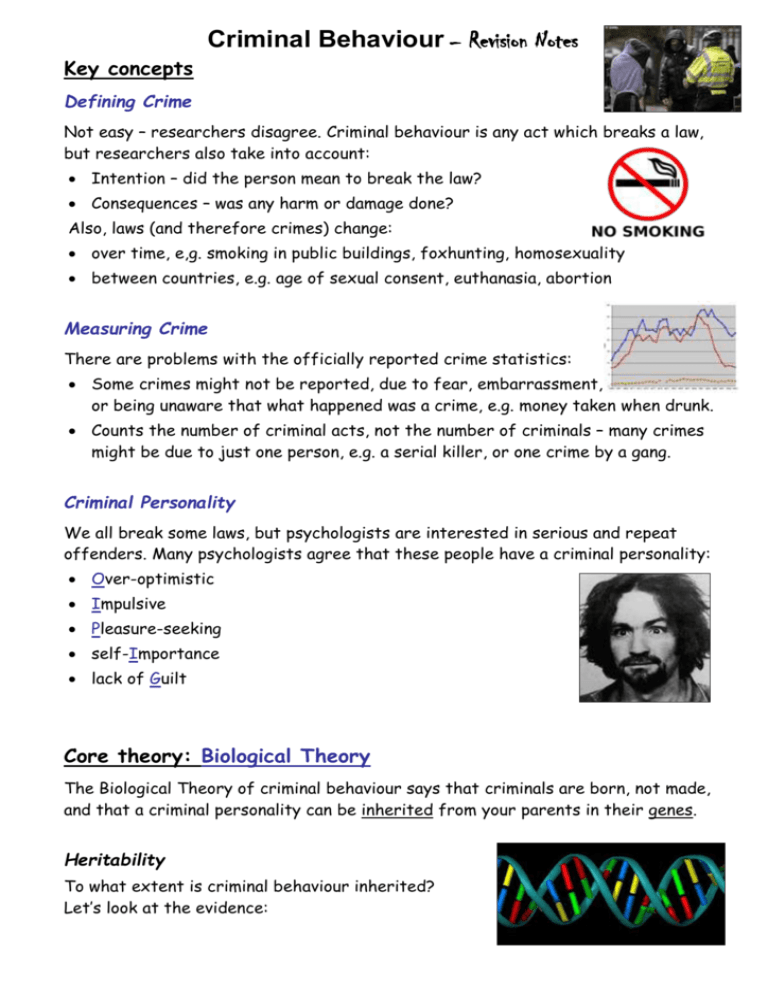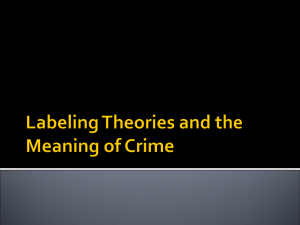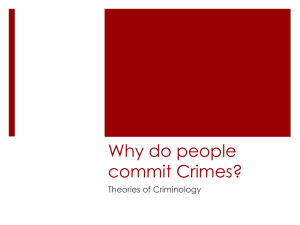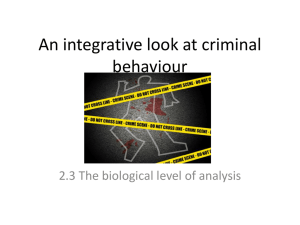Criminal Behaviour – Revision Notes
advertisement

Key concepts Criminal Behaviour – Revision Notes Defining Crime Not easy – researchers disagree. Criminal behaviour is any act which breaks a law, but researchers also take into account: Intention – did the person mean to break the law? Consequences – was any harm or damage done? Also, laws (and therefore crimes) change: over time, e,g. smoking in public buildings, foxhunting, homosexuality between countries, e.g. age of sexual consent, euthanasia, abortion Measuring Crime There are problems with the officially reported crime statistics: Some crimes might not be reported, due to fear, embarrassment, or being unaware that what happened was a crime, e.g. money taken when drunk. Counts the number of criminal acts, not the number of criminals – many crimes might be due to just one person, e.g. a serial killer, or one crime by a gang. Criminal Personality We all break some laws, but psychologists are interested in serious and repeat offenders. Many psychologists agree that these people have a criminal personality: Over-optimistic Impulsive Pleasure-seeking self-Importance lack of Guilt Core theory: Biological Theory The Biological Theory of criminal behaviour says that criminals are born, not made, and that a criminal personality can be inherited from your parents in their genes. Heritability To what extent is criminal behaviour inherited? Let’s look at the evidence: Brain Dysfunction Genes might affect the way in which parts of a criminal’s brain works: Pre-frontal cortex – connects anti-social behaviour with fear: - criminals might not fear the consequences of breaking the law. Limbic system – controls aggressive and sexual behaviour & empathy: - overactive nerve cells here in criminals can cause increased aggression - amygdala dysfunction causes criminals not to feel sympathy for victims Corpus callosum – links rational and irrational sides of the brain: - in murderers, communication between hemispheres is weak Temporal lobe – helps us to understand language and react emotionally: - less active in psychopaths There is evidence that these parts of the brain work differently in criminals. This might be due to genes, brain damage or disease. Facial Features If genes affect criminals’ personalities, they might also affect how their faces look. In the past, some psychologists claimed that criminals could be identified by their: Asymmetrical faces Sloping foreheads Glassy eyes Sticking-out ears Crooked noses Big jaws Lots of hair Criticisms (limitations) The biological theory ignores the effects of upbringing and environment – crime running in families could often be due to learning from parents. Not all criminals show brain dysfunction, so this can’t be used to predict who will become a criminal. There can’t be just a single gene that causes all the different types of crime, like theft, rape and fraud. There is little evidence that criminals have different facial features to noncriminals. Alternative theory: Social Learning Theory Young people observe role models committing crimes and imitate them. If this behaviour is reinforced (through material and social rewards, and avoiding punishment), it is more likely to be repeated. Vicarious Reinforcement – seeing others get rewards, like money and respect, can make you more likely to commit criminal behaviour. Core study: Mednick et al. (1984) Aim: To find out whether criminal behaviour is largely genetic (inherited). Research Method: Adoption study (retrospective correlational). Participants: 4000 adopted Danish men. Procedure: They compared the men’s criminal records with those of their biological parents and their adopted parents. Results: Those whose biological parents were criminals were nearly twice as likely to become criminals as those whose biological parents were not criminals. Those whose biological parents were criminals were more likely to become criminals than those whose adoptive parents were criminals. There was a strong correlation between biological parents and their sons for theft. Related brothers raised in different families were more likely to both be criminals than unrelated brothers raised in the same family. Conclusion: Genes play a large role in criminal behaviour, though environment also has an effect. Limitations/criticisms (what a MES): The criminal records might not be reliable, e.g. some might not have been caught or might have been convicted wrongly. Most adoptees spend some time with their biological parents before moving to adoptive parents, which might have had an effect even at a young age. The sample was biased – the participants were all male, so the findings cannot be generalized to females. Application: Crime Reduction Biological theory suggests that you can’t change criminals, so crime prevention and rehabilitation strategies won’t work. Most crime prevention strategies are based on SLT: - families, schools and TV should provide good role models (ban violent TV) - reinforce appropriate behaviour in children (rewards and punishments) - prison and fines can act as vicarious punishment (seeing it happen to others can make you less likely to commit crimes) Rehabilitation programmes try to change the behaviour of criminals: - some are behaviourist (rewards/punishments), others are cognitive (thinking) - as we learn more about the brain, could drugs or gene therapy help?










